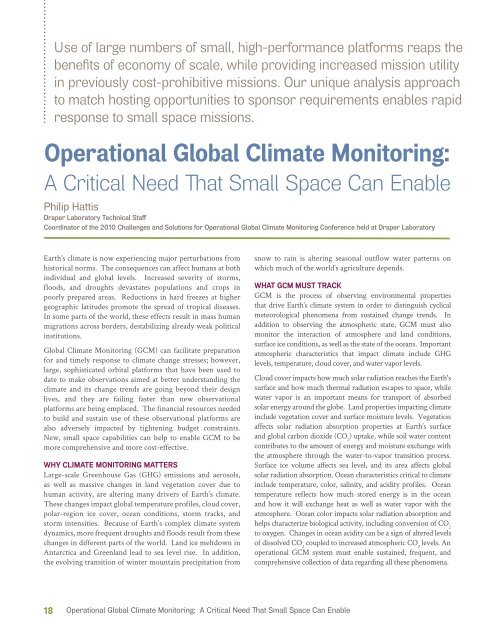The Draper Technology Digest - Draper Laboratory
The Draper Technology Digest - Draper Laboratory
The Draper Technology Digest - Draper Laboratory
You also want an ePaper? Increase the reach of your titles
YUMPU automatically turns print PDFs into web optimized ePapers that Google loves.
Use of large numbers of small, high-performance platforms reaps thebenefits of economy of scale, while providing increased mission utilityin previously cost-prohibitive missions. Our unique analysis approachto match hosting opportunities to sponsor requirements enables rapidresponse to small space missions.Operational Global Climate Monitoring:A Critical Need That Small Space Can EnablePhilip Hattis<strong>Draper</strong> <strong>Laboratory</strong> Technical StaffCoordinator of the 2010 Challenges and Solutions for Operational Global Climate Monitoring Conference held at <strong>Draper</strong> <strong>Laboratory</strong>Earth’s climate is now experiencing major perturbations fromhistorical norms. <strong>The</strong> consequences can affect humans at bothindividual and global levels. Increased severity of storms,floods, and droughts devastates populations and crops inpoorly prepared areas. Reductions in hard freezes at highergeographic latitudes promote the spread of tropical diseases.In some parts of the world, these effects result in mass humanmigrations across borders, destabilizing already weak politicalinstitutions.Global Climate Monitoring (GCM) can facilitate preparationfor and timely response to climate change stresses; however,large, sophisticated orbital platforms that have been used todate to make observations aimed at better understanding theclimate and its change trends are going beyond their designlives, and they are failing faster than new observationalplatforms are being emplaced. <strong>The</strong> financial resources neededto build and sustain use of these observational platforms arealso adversely impacted by tightening budget constraints.New, small space capabilities can help to enable GCM to bemore comprehensive and more cost-effective.WHY CLIMATE MONITORING MATTERSLarge-scale Greenhouse Gas (GHG) emissions and aerosols,as well as massive changes in land vegetation cover due tohuman activity, are altering many drivers of Earth’s climate.<strong>The</strong>se changes impact global temperature profiles, cloud cover,polar-region ice cover, ocean conditions, storm tracks, andstorm intensities. Because of Earth’s complex climate systemdynamics, more frequent droughts and floods result from thesechanges in different parts of the world. Land ice meltdown inAntarctica and Greenland lead to sea level rise. In addition,the evolving transition of winter mountain precipitation fromsnow to rain is altering seasonal outflow water patterns onwhich much of the world’s agriculture depends.WHAT GCM MUST TRACKGCM is the process of observing environmental propertiesthat drive Earth’s climate system in order to distinguish cyclicalmeteorological phenomena from sustained change trends. Inaddition to observing the atmospheric state, GCM must alsomonitor the interaction of atmosphere and land conditions,surface ice conditions, as well as the state of the oceans. Importantatmospheric characteristics that impact climate include GHGlevels, temperature, cloud cover, and water vapor levels.Cloud cover impacts how much solar radiation reaches the Earth'ssurface and how much thermal radiation escapes to space, whilewater vapor is an important means for transport of absorbedsolar energy around the globe. Land properties impacting climateinclude vegetation cover and surface moisture levels. Vegetationaffects solar radiation absorption properties at Earth’s surfaceand global carbon dioxide (CO 2) uptake, while soil water contentcontributes to the amount of energy and moisture exchange withthe atmosphere through the water-to-vapor transition process.Surface ice volume affects sea level, and its area affects globalsolar radiation absorption. Ocean characteristics critical to climateinclude temperature, color, salinity, and acidity profiles. Oceantemperature reflects how much stored energy is in the oceanand how it will exchange heat as well as water vapor with theatmosphere. Ocean color impacts solar radiation absorption andhelps characterize biological activity, including conversion of CO 2to oxygen. Changes in ocean acidity can be a sign of altered levelsof dissolved CO 2coupled to increased atmospheric CO 2levels. Anoperational GCM system must enable sustained, frequent, andcomprehensive collection of data regarding all these phenomena.18 Operational Global Climate Monitoring: A Critical Need That Small Space Can Enable
















